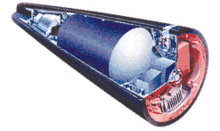Part 2 of 2 parts (Please read Part 1 first)
The study determined the number of W76 warheads that would be needed to attack a Russian missile base with hardened missile silos. The W76 warhead of that time had a fixed height-of-burst fuze. This means that the fuze could not adjust its detonation for the best location if the missile were falling short of the target or overshooting the target. Because of this, missile launched from submarines were mainly targeted at Russian military bases which were large enough that accurate targeting was not as critical as that required for destroying a hardened missile silo.
The report stated that an enhanced Mk4A reentry body with a new fuze design that allowed adjustment of the height of the detonation as it approach the target would have much improved capability to destroy a hardened target such as a missile silo. This meant that a smaller number of W76 nuclear warheads could reliably destroy a Russian missile base as compared to the old style with fixed-fuzes. The U.S. would be able to reduce the number of warheads on a submarine while increasing the lethality of an attack launched from a submarine.
When considering the accuracy of a missile warhead, there is a factor called the “miss distance” measured by something called the “circular error probable” (CEP). The CEP is defined as the radius of a circle around the targeted point within which half of the warheads aimed at a target are expected to impact. For a W76-1 ballistic missile warhead, the lethal distance on the ground and the CEP are about equal. This means that about half of a group of warheads with the old fixed-fuze systems should land close enough to a target to be within the lethal distance.
The new super-fuze for the W76-1/Mk4A has the ability to detonate at any height within the lethal volume over a target. Even though the super-fuze equipped warhead has basically the same ballistic accuracy as the old fixed-fuze versions, the chances that the super-fuze warhead will destroy the target are much greater than the chances for a fixed-fuze version of the warhead.
The super-fuze measures its altitude when it is above the atmosphere over the target. If the altitude measured is the altitude expected from the launch trajectory, then the warhead is exactly on target. On the other hand, if the altitude measured is higher than expected, the warhead would hit beyond the target and if the altitude measured is lower than expected, the warhead would hit short of the target. Armed with the actual altitude, the super-fuze is able to adjust the detonation for maximum destructive effect on the target.
Armed with a super-fuze, the probability that a missile will achieve a successful hit on a target is about eighty-six percent. If the missiles were using a fixed-fuze, then it would require at least three missiles to insure an eighty-six percent probability of success. In other words, the number of warheads on a submarine could be reduced by two thirds without reducing the success of an attack.
This great improvement in the targeting ability of the U.S. nuclear submarine fleet has not been publicized, although it has serious implications with respect to strategic stability. If it were widely known exactly what the super-fuze device can do, it would have a powerful impact on perceptions of U.S. nuclear strategy and intentions.
With more killing power resulting from the super-fuze, the small warheads on submarine missiles could take out Russian missile silos and many other targets. This would allow the use of more powerful land-based U.S. missiles to be dedicated to other targets. All in all, potential adversaries of the U.S. have to consider that the super-fuze augmentation of U.S. submarine warheads greatly improves the chances that the U.S. could successfully destroy an enemy such as Russia in a first-strike surprise attack.
W76-1/Mk4A warhead:
